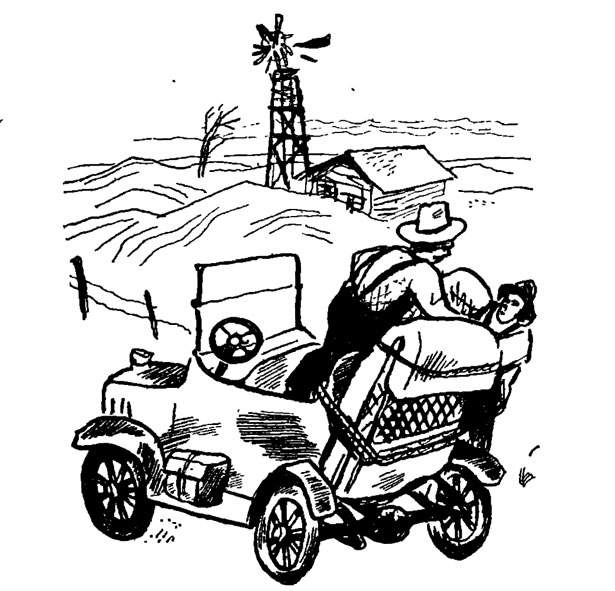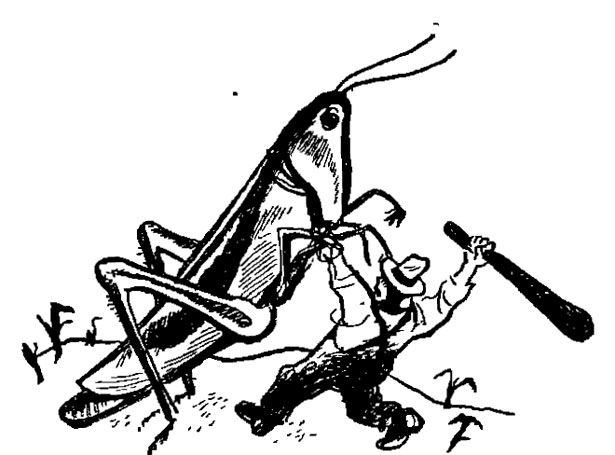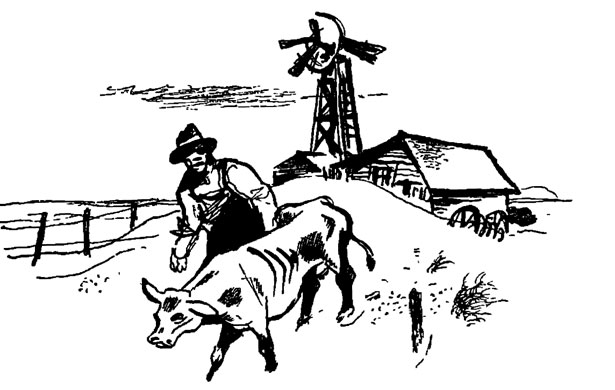
This week’s cover story by Sasha Abramsky, “Dust Bowl Blues,” explores the severe drought that has afflicted the American Southwest for the past few years, devastating crops, communities, and climates. “Just like in the days of the Dust Bowl,” Abramsky writes, “a way of life is under threat here, as are the livelihoods of millions of people.”
In the summer of 1937, with the original Dust Bowl and the second wave of the Great Depression in full effect, The Nation published four features, once each month, by the radical cartoonist and painter William Gropper, who, using Works Progress Administration funds, went on a tour around the country to document the resilience with which ordinary people were facing those twin man-made disasters. Gropper’s simple, evocative sketches and crisp paragraphs have the same effect as more famous artifacts of creative reportage from the American West of the late 1930s, like John Steinbeck’s novels or Woody Guthrie’s songs: that of making the reader or listener feel dusty just by reading or listening.
His first Nation dispatch that summer, “Gropper Visits Youngstown” (July 3, 1937), derived from the same visit to the Ohio city that produced his most famous painting, Youngstown Strike—recording the tumultuous scene at a major labor walkout led by the Congress of Industrial Organizations. But it is his August page, “The Dust Bowl,” that provides a remarkably poignant and sympathetic account of what the Southwest was like in those years:
When the wind blows, you get a blow of nice hot dust in your nose, eyes, and throat. The landscape is simple—sky and sand for miles. At night you can get some sleep with a wet cloth over your face, or if you’re prepared with a mask you can manage to get by until you get used to it. In Elkhart, Kansas, I saw a farmer plowing. No sooner did he pass with the plow than the dust blew over and covered up the earth as if nothing had happened. I asked him if he got any crops, and he said, “No.” “Then why plow?” And he said, “Been doin’ it fer years; it’s a habit now,” and went on with his plowing.
Popular
"swipe left below to view more authors"Swipe →
Another blurb tells a story that any American reader, thanks to Steinbeck and Guthrie, can relate to—though Gropper, because he is using a weekly magazine and not a novel or a song, manages it with perhaps more immediacy:
More than once on the road I’ve seen families packing their belongings in old Fords and leaving the old homestead. Many of them, I’ve been told, are migrating to California—not because they want to, but because they have been evicted.

* * *
The Nation’s next and, until Abramsky’s piece this week, last article about the Dust Bowl was written by Kunigunde Duncan (a pseudonym for the Kansan writer Flora Isely) in 1939. In “Reclaiming the Dust Bowl,” Duncan wrote about how farmers on the high plains were using technology and grit to reconstitute the soil and finally beat back the dust storms of the previous six years. As Abramsky details the ways in which human-caused global climate change have contributed to and exacerbated the present drought in the Southwest, Duncan reported that the Dust Bowl of the 1930s was similarly attributable to human actions:
The Dust Bowler, seeking means of combating these terrible conditions, went first into causes and found that he was having to fight more than super-temperatures, water shortage, and constant wind-whipped dust. He was having to fight the mistakes of his predecessors.
Duncan blamed railroad tycoons and the settlers they brought in by the hundreds, who forced the land to produce crops from the East; cattle ranchers who overgrazed the prairie; and the World War I demand for bread which led farmers to replace drought-resistant native buffalo grass with fields and fields of wheat. Her description of the disaster that ensued has echoes of Gropper’s—and Steinbeck’s, too:
The high plains have never had abundant rainfall. But when the annual precipitation of from fourteen to twenty inches decreased to from eight to fourteen, the situation became acute.

It might be worth noting that the average rainfall in Lubbock, Texas, the town profiled in Abramsky’s “Dust Bowl Blues” this week, enjoyed a grand total of 11.43 inches of precipitation in 2012, according to the National Weather Service. In 2011, it had less than 6 inches. In 1937, it had 22.25 inches. Duncan continued:
“Dusters” began to boil up and shut out the sun, and everywhere the question was asked, “What shall we do?” It was a question that remained unanswered for many months while gas engines refused to run and locomotives crawled through a springless, viewless land—a land where people live with windows weather-stripped tightly with adhesive tape to exclude the penetrating silt; where wet sheets were hung above beds and about the walls to save the lives of the old, the ill, and the new-born…where a weird purplish sun guided the funeral procession of those who had died of dust pneumonia.
* * *
Abramsky reports that not only is the present drought crisis in the Southwest, to some extent, a human-caused phenomenon, it continues to be exacerbated by a broken American political system.
Congress has an opportunity to address this crisis through the farm bill, which is currently the topic of robust debate in Washington. On July 11, with help from the powerful agribusiness lobby, the House passed legislation giving large farms the ability to buy “shallow loss insurance,” which would guarantee up to 90 percent of their income—thus providing a perverse incentive for agribusiness to try to cultivate land manifestly unsuited to the crops in question.
Two years ago, as it became apparent that this would be an especially contentious episode in the perpetual drama that is the farm bill’s quinquennial renewal, the ecology writer and activist Daniel Imhoff wrote in The Nation about the prickly questions embedded in the debate—and, like Abramsky, connected the dots between agricultural legislation, drought and climate change:
Generous crop insurance programs and increasing global demand for animal feed and biofuels have triggered an aggressive expansion of farming and ranching activities into marginally productive areas. Water tables are plummeting and aquifers are being depleted. Soil erosion is on the rise. Agriculture contributes to greenhouse gases, loss of biodiversity, chemical runoff in waterways, compromised animal welfare and food contamination. Farm bill conservation programs could be the only thing that stands between us and another Dust Bowl, collapsed watershed or imperiled species.
Sure enough, the farm bill passed by the House earlier this month—in addition to stripping out the food-stamps program, thereby sundering the traditional farm-bill coalition in two—disconnected conservation compliance from crop insurance payouts, essentially declawing the bill’s already insufficient environmental-protection provisions. If the new Dust Bowl gets any worse, we may have to start looking for the next William Gropper.



